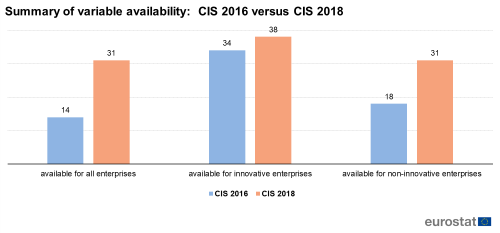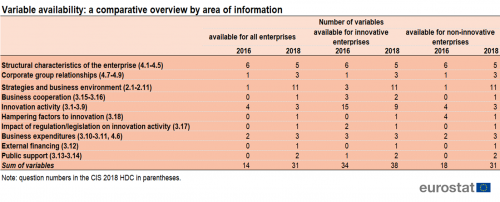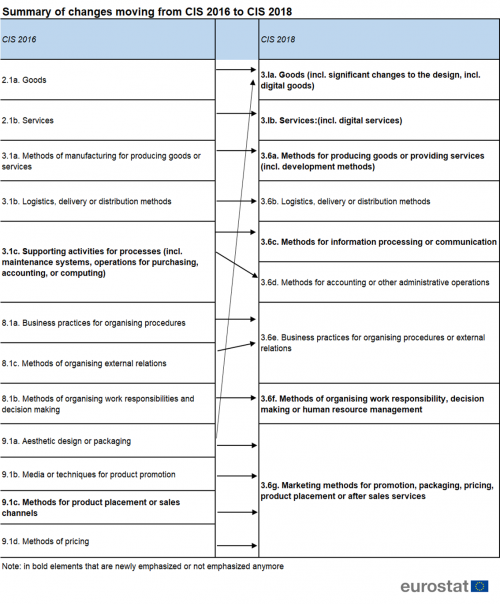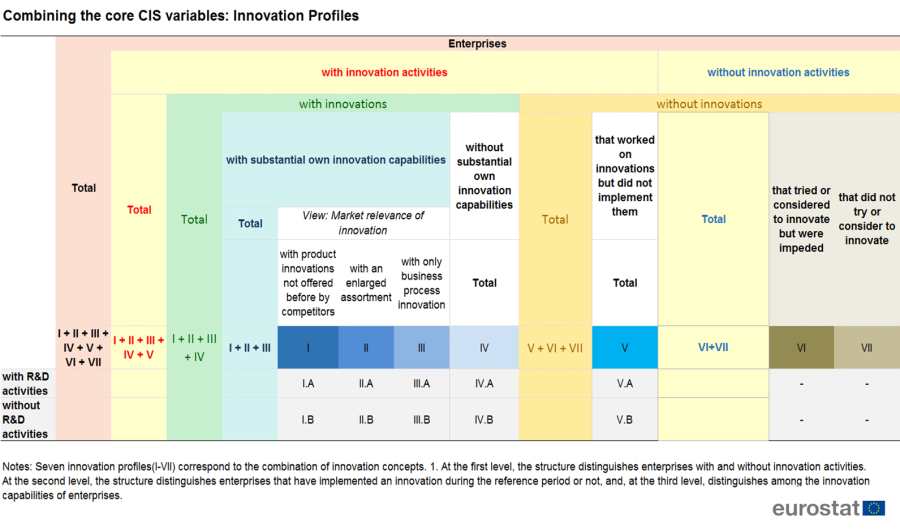This article was published in December 2021
This background article explains the Community Innovation Survey (CIS) and the substantial revision that the survey has undergone between the 2016 and 2018 rounds. The revision efforts were directed to: (i) improve the quality of the CIS data as well as to increase the efficiency of data production, (ii) to take account of major aspects of the revision of the Oslo Manual (OM) ‘Guidelines for collecting and using data on innovation’ of 2018, (iii) to increase policy relevance of the CIS informative content, and (iv) to increase the usability of the statistical outputs of the survey.
Introduction
Business innovation refers to the wide range of activities that enterprises undertake in order to implement innovation processes, to develop new products and services, and to deliver them to the market.
The Community Innovation Survey (CIS) has been the reference for information on business innovation in the EU since 1992. It provides information that goes beyond the traditional indicators of the innovative effort (i.e. R&D intensity) by covering different kinds of processes and decisions related to the innovation management. Because of the rich information, the CIS is widely used in EU and national policy reports, e.g. the European Innovation Scoreboard, as well as in many different research studies focusing on business innovation. As an implementation of the Oslo Manual (OM) ‘Guidelines for collecting and using data on innovation’ of the OECD and Eurostat, the CIS has undergone a step-by-step evolution aimed at better grasping the knowledge transformation at the basis of the economic change.
After the 4th revision of the Oslo Manual (OM4) that took place in 2018, the CIS has undergone a substantial changes. The revision efforts were directed to: (i) improve quality of the CIS data as well as to increase the efficiency of data production, (ii) to take account of major aspects of the revision of the Oslo Manual , (iii) to increase policy relevance of the CIS informative content, and (iv) to increase the usability of the statistical outputs of the survey. These aspects are discussed in this article.
The aim of the changes to the CIS was to open up to a broader usage by anyone interested in comparative data on enterprises. In its former design, the CIS mainly attracted users who sought statistical data specifically about business innovation. The attempt to reflect the complexity of different aspects and kinds of innovation led to a complex structure of results and tabulations. In its new design, the enterprise has been put back into the center, leading to a clearer structure of the statistical output. Business innovation is seen as one important feature of enterprises, and their innovation behavior is used to classify the enterprises into different types. Data on most variables is now available for all enterprises in the statistical population, structured along this classification. Future work on innovation profiles of enterprises will become a central analytical tool that puts the new design into practice and facilitates data analysis.
European legislation for the CIS
Under European Regulation (Regulation 995/2012) CIS data are collected every two years (even years). For each round, a core set of variables has been identified to be obligatory in order to produce internationally comparable statistics and indicators. These variables are aimed at collecting basic information on the enterprise, at investigating the importance of new or improved goods or services, at capturing the relevance of the innovation developed (new to the market or new to the firm), and at understanding the role played by the enterprise in the innovation development process. In the same manner, the Harmonised Data Collection (questionnaire) includes information on the new or improved business processes developed. Other mandatory variables are specifically focused on the process of innovation development, in order to explore the range of innovation activities undertaken by the enterprise, relative expenditures, and innovation co-operation.
Additional variables are collected by Member States on a voluntary basis, to cover a wider set of topics linked to enterprise strategies, customisation and co-creation, intellectual property rights (issuing and usage), knowledge inflows and management methods, funding and financial support, and the impact of external factors on innovation. Commission Regulation No 995/2012 has been in force since 2012 and was so still for the CIS 2020. The CIS 2022 and subsequent survey rounds will be covered by Regulation 2152/2019 on European Business Statistics (EBS) as well as an Implementing Act dedicated to the topic ‘business innovation’. The objectives of this Implementing Act have been anticipated by the redesign of the CIS, so that data on business innovation will be better integrated into its context of European Business Statistics.
Improved quality
There is always a certain margin of discretion for enterprises when reporting about innovation. Respondents have to evaluate whether changes to products and processes ‘differ significantly’ from previous products and processes of the enterprise. Only if they do so will they qualify to be an ‘innovation’. Until the CIS 2016, the CIS applied a filtering approach to the questionnaire. A large part of the questionnaire was directed to enterprises that reported innovations or innovation activities while enterprises with neither innovation nor innovation activities had to respond to a small number of questions only. This approach had disadvantages:
- The – to some extent ‘subjective’ – decision whether there was innovation in the firm determined the statistical output: a different data set became available for firms where the answer was ‘yes’ than for firms where the answer was ‘no’. The CIS provided almost no information about firms without innovations or innovation activities[1]. This impeded the comparative analysis of ‘innovators versus non-innovators’[2], despite the fact that this comparison is of great importance for policies aiming at increasing firm’s propensity to innovate.
- Different data set became available for different kinds of innovation (product, process, organisational and marketing; see also next section).
- The questionnaire design was likely to result in some response bias as enterprises may have chosen to report no innovations and no innovation activities in order to reduce the effort for responding to the questionnaire (particularly in case of obligatory surveys)[3].
In the CIS 2018, the questionnaire was changed in order to avoid filtering. This was made possible by rephrasing questions in a way that they apply to all types of enterprises. Additional information related to innovation is collected as part of each question. For example, the previous question on innovation co-operation has been re-phrased to a question on co-operation in general while offering several items on the type of co-operation that allows to separate co-operation on innovation activities from other types of co-operation. This resulted in a more balanced approach, because the major part of the questionnaire examines relevant activities for all enterprises, and focuses on innovation only where necessary. This change allowed to increase the comparability of the statistical outputs between groups of enterprises, i.e. not only for the standard groups of total enterprises, innovative enterprises, and non-innovative enterprises, but also for specific innovation profiles that may be developed by combining more than one survey question.
Results for most survey variables are available for all enterprises, i.e. independent of their innovation behaviour, making them relevant for any user looking for information about the whole statistical population of enterprises with 10 or more persons employed. As Figure 1 indicates, the number of variables available for both the innovative and the non-innovative enterprises has substantially increased from 14 in the CIS 2016 to 31 in the CIS 2018. More importantly, data enrichment mainly concerns the non-innovative group of enterprises, which in the new CIS have only 7 variables less than the innovative ones.
Another major change of the CIS 2018 is a more precise measurement of business expenditures. The questionnaire contains a question which is designed to facilitate reporting overall business expenditure by adopting standard cost categories and a simplified question on innovation expenditure with a reduced number of categories: 'R&D in-house', 'R&D contracted out', and 'Other' (Components of 'Other' category are explained and can be provided on a voluntary basis). Both questions are directed to all enterprises.
Finally, the definitions of all such variables, which are used in other data sources of official statistics [4], have been aligned, so that they are now generally valid under the new framework for European Business Statistics (EBS). This facilitates the data integration requested by the EBS Regulation, and is thereby a condition for Micro Data Linking (MDL) of CIS data to data from such sources. Moreover, it can reduce the burden to the responding enterprises where National Statistical Offices use all information already available to them, e.g. to pre-fill it in online surveys[5]. This is why the term ‘model questionnaire’ for the CIS has been appropriately renamed to ‘CIS Harmonised Data Collection (HDC)’.
Taking account of major issues of the revision of the Oslo Manual
The CIS review addresses the issues with central importance for the OM4 revision. The questionnaire design in the CIS 2018 reflects this change with an improved flow of questions (see Figure 2 for a comparison with the CIS 2016).
Together with the increased number of variables available for all the enterprises, the clear advantage is that of enabling a comparative and broader use of the results of the CIS HDC. Only for those questions where filters are unavoidable[6] filters are actually applied. As can be seen from Figure 2, ‘skipping the survey’ is less inviting for ‘less inclined’ respondents because the amount of questions they would skip by (falsely) declaring to have no innovation is limited. Also, the set of information is now the same for all kinds of innovation, i.e. it is no longer different for marketing and organizational innovation as compared to product and process innovation.
The CIS 2018 HDC first examines Innovation Strategies (2.1) and practices like Customization (2.2-2.4) and IPR applications (2.5). Then it considers Knowledge flows like Intellectual Property Rights (IPR) use (2.6), acquisition of technical services (2.7) and machinery (2.8), information (knowledge) sources (2.9) and organizational practices (2.10). The central section is focused on Innovation output (3.1-3.8), Innovation activities (3.9), and Innovation expenditures (3.10-3.11). It continues by examining External drivers and enablers of business innovation, like funding (3.12), public support to innovation (3.13-3.14), co-operation and type of co-operation partners (3.15-3.16), hampering/supporting legislation (3.17) and hampering factors (3.18). Finally, some additional indicators are collected, like the number of persons employed (and the relative share of tertiary educated employees) (4.1-4.2), total turnover and its geographical distribution (4.3-4-4), firm age (4.5), expenditures (4.6), group membership (4.7) and intra-group flows (4.8-4.9).
Building on the questionnaire sections, the comparative overview of variable availability by specific area of information points out that the general increase of data collected for all the enterprises has similarly affected the various categories (Table 1). Information on the enterprise strategies and business environment, business cooperation, the impact of regulation/legislation on innovation activity, and the public support to innovation is now available also for the enterprises without innovation activity. The new data on external sources of finance are available for all the enterprises in the new CIS, offering an additional perspective to business analysts, thus complementing the data on structural characteristics and corporate group relationships.
A very concrete impact of the OM4 review is the reduction of the basic definitions of a business innovation from the four types of innovations (product, process, organisational and marketing) presented in the OM3 to two main types: product innovations and business process innovations. The aim of this change is to facilitate reporting and comparisons across the entire business sector, including those enterprises specialised in providing knowledge-based services.
The definition of business process innovation merges the CIS 2016 questions on process, marketing and organisational innovation (see Figure 3) and, thus, includes all the business functions related to both the core activity of producing and delivering products for sale, and other supporting operations characterizing the most advanced services activities. There is one element of prior marketing innovation that has been moved to product innovation - significant changes to product design. This shift is reflected by a change in the definition of product innovation that now also refers to changes in design.
For business process innovation, two elements have been included that were not explicitly mentioned in the CIS 2016 definitions of process, marketing or organisational innovation: new or improved methods related to developing products, services or processes, and new or improved methods in after sales services.
The CIS 2018 changes have unavoidable impact on the direct comparability with previous waves. Although more analysis is needed to disentangle from the real time pattern of the data the conjunct effects of filters removal and concept redefinition, we present some preliminary comparisons as an additional descriptive analysis based on the most relevant concepts[7].
Figure 4 reports for the CIS 2016 and the CIS 2018 the enterprises by type as a share of the reference population. The comparison indicates a reduction in the share of non-innovative enterprises, i.e. those enterprises without any innovation activity during the reference period, of almost 8 percentage points (p.p.). The corresponding increase in the share of innovative enterprises is significantly driven by those enterprises introducing at least one new or improved good or service (more than 4 p.p. increase), regardless of any other type of innovation activity. Compared to the CIS 2016, the share of innovation-active enterprises with on-going or abandoned activity before the implementation of an innovation has reduced by 2 p.p.

Source: Eurostat (inn_cis11_bas) and (inn_cis10_type)
Increased policy relevance
Contrary to the past, the CIS 2018 takes better account of the diversity of enterprises in the EU, thus better delivering policy relevant information needed to understand what distinguishes strong innovators from low innovators or non-innovators.
The availability of fully comparable information for all enterprises reinforces the CIS's multi-purpose feature. Using the full set of enterprise characteristics and combining them in non-overlapping categories makes it possible to identify different enterprise profiles in regard to innovation capabilities and objectives. Along this conceptual framework, the definition of Innovation Profiles represents another concrete implementation of the OM4 that can provide better information to policy makers.
In the future, Innovation Profiles will provide a complete non-discriminative presentation, possible as a result of the streamlined question on the different kinds of innovation. They can thus provide better information to analysts and policy makers than one-dimensional standard indicators. Together with the traditional concepts and definitions used in the CIS survey, innovation profiling displays how enterprises innovate, allowing to capture the full picture needed to understand business innovation.
Measuring the economic determinants and consequences of innovation
The CIS is the most important tool to get through the black box of innovation at the firm level with comparable and consistent data. The changes to the questionnaire have made it possible to collect data not only on the input and the output of innovation process, but also on important structural characteristics of all the enterprises involved in the survey.
To promote an even better understanding, additional efforts are required for investigating economic determinants and consequences of innovation.
There have been several attempts in the past to collect information on the economic impact of innovation. The measurement of the outcome of business innovation is also a concern of the Oslo Manual 4th edition (OM4, Chapter 8). However, the attempts for a concrete measurement of the outcome of business innovation in the CIS have not yet been fully convincing.
More recently, work has been intensified within the CIS Task Force to complement the CIS information with key variables produced in the Structural Business Statistics by using MDL techniques. This work aims at an approach that might link information on innovation in firms to their economic performance. This might lead up to ‘hard’ information (i.e. quantitative economic indicators) instead of subjective information[8], without increasing response burden.
The work undertaken aims at developing a multi-country infrastructure that preserves EU-wide comparability while safeguarding the quality of data. To this respect, more specific reflections have started with national experts in the SBS and CIS domain. The discussion is focused both on (i) the methodological issues related to linking microdata coming from different sources and for different points in time to take into account time lag respect to innovative activity; (ii) what kind of deliverables should become available at the EU level and at what level of disaggregation.
Source data for tables and graphs
Data sources
The Community Innovation Survey (CIS) is a survey about innovation activities in enterprises. The survey is designed to capture the information on different types of innovation, to enable analysis of innovation drivers or to assess the innovation outcomes. The survey focuses, among others, on the following aspects:
innovation activities, innovation expenditure, innovative products (new to firm; new to the market), turnover from innovative products, business process innovation, incentives for implementation of innovation, innovation cooperation, source of financing of innovation, sources of information on innovation, innovation barriers, etc.
The information collected allows measuring the innovativeness of business sectors (B-C-D-E-46-H-J-K-71-72-73).
The CIS provides various innovation indicators by three main breakdown variables: type of innovator, economic activity and size class of enterprise. The following size classes of enterprises according to number of employees are included in the core target population of the CIS 2018:
10 - 49 employees, 50 - 249 employees, 250 or more employees.
The innovation survey was first launched in the 1990s and became a regular biennial data collection starting from CIS4 (2004) in the EU Member States, EFTA countries and EU candidate countries. Since its launch the survey was based on the methodology laid down in the Oslo Manuals — international standards for conceptualising and collecting data on innovation. The first Oslo Manual was published in 1992. It has been revised on three occasions to take into account the experience and expand its measurement framework — in 1997, 2005 and in 2018. The CIS 2018 is the first CIS after the review of the Oslo Manual in 2018, resulting in its 4th edition (Oslo Manual (2018), 4th Edition).
For each survey round, Eurostat together with the countries develops a standard core questionnaire – Harmonised Data Collection (HDC) – listing the mandatory and rotational questions to be provided within a given round. The questionnaire includes the set of definitions and methodological recommendations to assure the comparability among countries.
CIS 2018 results are collected under Commission Regulation No 995/2012. This Regulation defines the mandatory target population of the survey referring to enterprises in the core NACE categories with at least 10 employees. Eurostat recommended using ‘person employed’ as size class unit already for the CIS 2018 in order to comply with the latest measurement standards in European business statistics and recommendations of Oslo Manual, 4th edition. The standard mandatory questions refer to number of innovative enterprises, product and goods new to the market and new to the firm, innovation cooperation, objectives of innovation, sources of information for innovation, hampering factors, innovation developer, turnover from innovation and expenditure on innovation. The following questions were new in CIS 2018: customization and co-creation, patents and IPRs, buying technical services, innovative purchases, using information channels, organising work and expectations from innovation.
Most statistics in CIS 2018 are based on the 3-year reference period 2016-2018, but some use only one calendar year (2016 or 2018).
Context
Within the statistical information system on science, technology, and innovation, business innovation statistics represent a crucial piece of knowledge to support and monitor EU policies.
Under the umbrella of the Commission Regulation (EU) 2152/2019 , innovation statistics will be better integrated into the context of European Business Statistics. The redesign of the CIS has anticipated this critical change, thus allowing for an increasing harmonization of the CIS data among business statistics. This change represents a necessary step for having data more and more harmonized among the EU countries, thus supporting EU policy monitoring. Also, the integration of data on business innovation will allow for a better understanding of the economic determinants and consequences of innovation.
In the Innovation Union flagship initiative, the European Innovation Scoreboard provides a comparative analysis of innovation performance in EU countries, other European countries, and regional neighbours. It assesses the relative strengths and weaknesses of national innovation systems and helps countries identify areas they need to address. The regional extension, the Regional Innovation Scoreboard, is relevant for assessing the innovation performance across 240 regions of 22 EU countries using a limited number of indicators.
Data on business innovation are a basis for the Commission’s report Science, Research and Innovation Performance of the EU (SRIP). The report provides a thorough analysis of the research and innovation performance in Europe and formulates recommendations for the future.
Under the European Green Deal it will be crucial in the following years to trace the technological change that the green economy transition will determine in the medium-long term. The CIS will be the natural source of information to provide data on innovations with environmental benefits and data on the perceived relevance of climate change for businesses to support related policymaking.
Notes
- ↑ Initially, the filtering approach was used to reduce the response burden of enterprises with no innovations or innovation activities.
- ↑ Or any more sophisticated classification along innovation behaviour of firms.
- ↑ Conversely, in countries where replying to the CIS is not obligatory, there might be a tendency to under-estimate the number of non-innovators as non-innovators may think that an innovation survey is not relevant to them and hence refrain from responding.
- ↑ Like the Business Register or Structural Business Statistics.
- ↑ More than 80 % of all CIS data collection in the Member States are executed as online surveys. Such practice can also help to verify the available information and thereby improve the quality of official statistics on enterprise quite generally.
- ↑ e.g. ‘Who developed the product innovation’ only for enterprises that have a product innovation.
- ↑ Direct comparison in terms of business process innovation is not reported given this is a new concept that merges the previously separated process, marketing and organisational innovation.
- ↑ Some past version of the CIS reported about ‘expectations met’ in regard to innovation. This is by definition subjective and report more ‘expectations not met’ particularly where expectation were high at the outset.
Explore further
Other articles
Database
- Community innovation survey (inn)
- Results of the community innovation survey 2018 (CIS2018) (inn_cis11)
Thematic section
Publications
Selected datasets
Methodology
- Oslo Manual
- Community innovation survey 2018 (CIS2018) (inn_cis11) (ESMS metadata file — inn_cis11)





